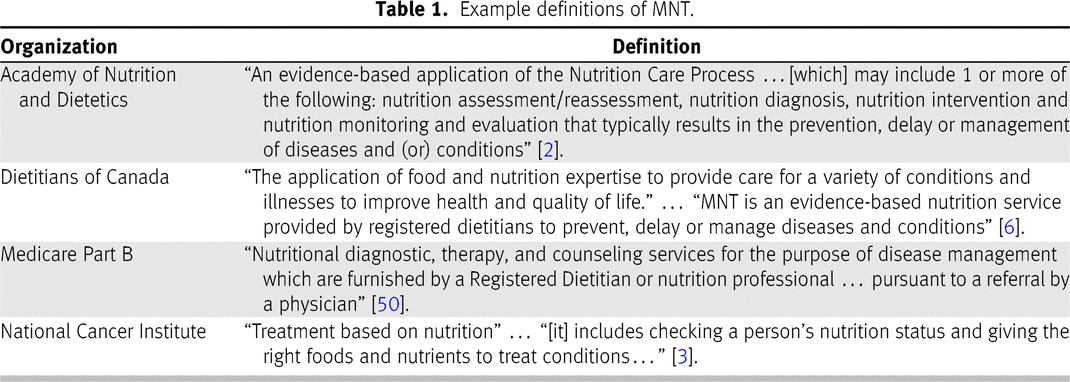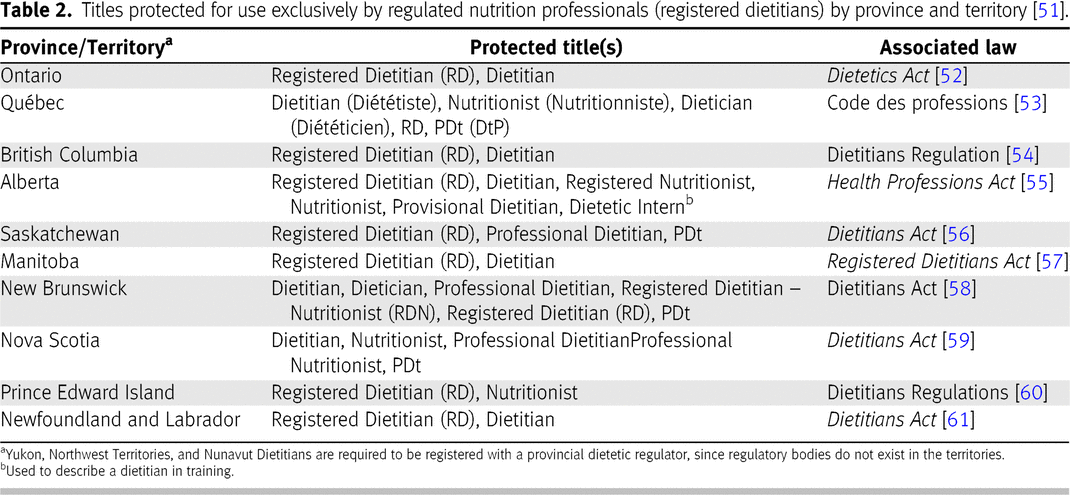LACK OF MNT REGULATION: OVERVIEW OF RISKS AND CONCERNS
The United States has legally protected MNT in several states [
8], but in Canada, MNT is not currently protected under legislation in any province or territory (see, for example, Ontario’s Regulated Health Professions Act [
9]). This is problematic, as anyone can provide MNT information and advice in clinical practice, online, or at group events regardless of their training, education, and/or the evidence-based nature of their practice (or lack thereof). Consequently, nutrition misinformation is a concern, putting the public at risk of harms to their health, well-being, and financial status [
10]. Documented examples of such harm include permanent pediatric vision loss due to vitamin A deficiency as a result of following an overly restrictive diet without appropriate supplementation [
11,
12], the development of serotonin syndrome after following an internet-recommended herbal “detox” [
13], and the “clean eating” trend that has been associated with indicators of disordered eating in young adults [
14].
A recent cross-sectional survey in Ontario has demonstrated that the public does not have the ability to correctly differentiate between registered dietitians, who are mandated to practice evidence-based nutrition, and other nutrition practitioners [
15]. An analysis of online blog posts found that these unregulated nutrition practitioners provide less scientifically rigorous nutrition information/advice (specific to detoxification diets) compared with registered dietitians [
16]. It is a moral imperative to ensure that the public is informed in making decisions about accessing various types of health care [
15]. Legislation also helps to protect the public by placing restrictions or mandates on activities that could pose risks of harm to the public [
17]. As effectively stated by the Government of Saskatchewan, “Regulated occupations are in place to protect the health and safety of [individuals] and provide consumer protection” [
18]. Conversely, unregulated health care providers (HCPs) are not obligated to abide by any standards of practice. Several of these unregulated providers of health and nutrition information have been critiqued by the scientific community for their lack of evidence-based practice and safety concerns including naturopathy, herbalism, healers, homeopathy, Ayurveda, and traditional Chinese medicine [
19–
22]. Consumers’ risk of obtaining unproven, misleading, and potentially harmful nutrition information and advice is not limited to one-on-one health care services; many individuals look to the internet for food and nutrition information [
23]. Harms and lack of evidence-based practice stemming from internet-based nutrition advice have also been documented [
13,
14,
16].
MNT can include complementary and alternative medicine (CAM), which often lacks solid research on which to base sound decisions [
24], yet it is promoted for the treatment or prevention of serious conditions such as kidney disease, cancer, diabetes, and hypertension [
22]. Health and safety concerns of CAM and nutritional supplements have been around for many years; Angell and Kassirer [
25] summarized these concerns in
The New England Journal of Medicine more than 2 decades ago. Documented side of effects of CAM include allergic contact dermatitis, organ toxicity, severe nutritional deficiencies in children, and liver injury [
26,
27]. Other possible risks of harm associated with CAM include delayed effective scientific-based treatment and ingestion of possibly harmful substances—either those listed on the label, or contaminated substances such as heavy metals [
25]. A retrospective study suggested an elevated risk of death in patients with curable cancer who chose to be treated with CAM, rather than conventional cancer treatment [
28]. With a lack of MNT regulatory oversight, anyone can provide recommendations for nutrition supplements and herbal products regardless of their knowledge of the safety, efficacy, and science behind these products. In addition, there are major safety concerns with products available on the market; well over half of the natural health products analyzed by Health Canada were found to be noncompliant with regulatory standards [
29]. The compliance issues or concern related to contaminated products, adulterated products, and deceptive or misleading advertising [
29]. Moreover, a Cochrane review found that antioxidant supplements including beta-carotene, vitamin E, and vitamin A (in high doses) significantly increased mortality [
30], yet these products remain widely available for sale directly to consumers and through nutrition providers.
PERSPECTIVE: LEGALLY PROTECTING MNT CAN HELP PROTECT THE PUBLIC
The problematic nature of nutritional health care in Canada (and elsewhere) has led us to critically reflect on and propose a solution to alleviate the significant concerns noted above. This article provides an overview of the perspective that legally protecting MNT as a controlled act (i.e., a legally controlled activity) reserved exclusively for those qualified to practice MNT safely and effectively, is of utmost importance to protect the public.
This article aims to first, establish a standardized definition of MNT for use in legislation across Canada. Next, this article proposes a list of HCPs who should ideally be exclusively authorized to provide MNT. Last, this article proposes legislative amendments aimed to help reduce nutrition misinformation and risk of harm across Canada through the regulation of MNT. We also discuss opposing perspectives to the proposed legislative amendments to provide a comprehensive picture of the issues at hand, with a pragmatic, real-world perspective in mind.
TOWARDS A STANDARDIZED DEFINITION OF MNT
The question of how to define MNT requires careful consideration. The list of MNT definitions presented in
Table 1 is certainly not exhaustive. It is interesting to note that existing definitions tend to specify that MNT is evidence-based and/or is provided by registered dietitians; this is a key problem with the existing definitions, if MNT were to be defined under governing legislation. While we agree that MNT should be evidence-based, many sources of nutrition information/advice are providing scientifically invalid (nonevidence based), misleading, and or/potentially harmful MNT information (see Toth et al. 2019 [
16] and Caulfield et al. 2014 [
31]). If MNT is to be added to health care legislation as a protected aspect of practice for certain regulated HCPs (who are already mandated under regulatory Colleges/Orders to practice in an evidence-based manner), then “evidence based” should not be included in the definition. If “evidence based” were included in the MNT definition, then only evidence-based MNT would be a legally protected aspect of practice, but not pseudoscientific MNT. This would not be solving the ultimate problem of nutrition misinformation communicated to the public.
As such, with the aim of appropriately defining and unifying the definition, the proposed definition is a slight modification of the Academy’s definition [
2], given the current reality that MNT is not always evidence based. The proposed standardized definition of MNT for use across Canada is:
The provision of nutrition information/advice (dietary or supplemental) for the assessment/reassessment, diagnosis, intervention or monitoring of a disease or condition, to treat or manage symptoms and/or medical conditions.
Aspects of the proposed definition could be interpreted in various ways and are thus worthy of further clarification. It should be specified that “diagnosis” refers to a nutrition diagnosis (as opposed to medical diagnosis), such as those listed in the Nutrition Care Process standardized terminology list [
32]. According to the proposed definition, MNT would include the provision of information and recommendations related to weight management, as obesity is recognized as a chronic disease in Canada and elsewhere [
33,
34]. MNT would also include any information or advice related to food allergies or intolerances as well as Celiac disease and other digestive conditions. Any recommendations to correct nutrient deficiencies or improve biochemical markers would further be considered MNT.
This definition does not include the provision of general nutrition information/advice for general health, such as recommendations to consume more fruits, vegetables, whole grains, lean protein sources, healthy fats, and dietary fibre, or to find healthier snack ideas and drink more water. Legally protecting MNT would thus still allow HCPs not listed under provincial and territorial MNT legislation to provide this general, lower-risk information and advice to the public.
PROPOSED LEGISLATIVE AMENDMENTS
The next question at hand is: who should be permitted to provide MNT? At first thought, it may seem appropriate to legally protect MNT as an aspect of practice exclusively for registered dietitians—the experts in evidence-based nutrition. However, some aspects of MNT fall within the scope of practice of other regulated HCPs (e.g. hypoglycemia treatment from medical doctors (MDs)). Given this, it would be detrimental to health care to exclude these HCPs from MNT legislation, as it would not allow them to practice aspects of MNT that fall within their scope. Thus, the information described below describes the perspective that MNT should be a legally protected health care activity across Canada under provincial and territorial legislation, reserved exclusively for use by the following regulated, evidence-based HCPs: registered dietitians, MDs, nurse practitioners (NPs), physician assistants (PAs), registered nurses (RNs), registered practical nurses (RPNs), speech language pathologists (SLPs), occupational therapists (OTs), physical therapists (PTs), midwives, paramedics, dentists, dental hygienists, optometrists, and pharmacists. Note that protected titles for use by registered dietitians differ by location in Canada (
Table 2). It is important to highlight that while we propose MNT be reserved exclusively for these HCPs, their level of training, knowledge, and expertise in nutrition is highly variable. Therefore, HCPs must recognize nutrition care practices that are outside of their scope of knowledge and refer to the appropriate HCP, such as registered dietitians, in these cases. Oversight from regulatory bodies helps to ensure that these HCPs do not practice outside of their scope. It should be noted that while PAs are not regulated in all provinces/territories [
35], their work is overseen by supervising, regulated MDs [
36]. We propose that MNT be legally protected through amendments to existing Acts summarized in
Supplementary Table 11.
There are aspects of MNT that fall within the scope of practice and knowledge of HCPs beyond registered dietitians. For example, educating patients on hypoglycemia treatment falls within the proposed definition of MNT and is an important component of the practice of registered dietitians in addition to MDs, NPs, PAs, RNs, RPNs, OTs, PTs, paramedics, and pharmacists [
37–
40]. Midwives provide prenatal nutrition education [
41]. Optometrists provide information on dietary strategies for optimal ocular health, such as omega-3 recommendations [
42]. Dentists and dental hygienists provide recommendations to reduce sugar intake for the prevention of dental carries [
43]. SLPs recommend dietary interventions to aid in the management of dysphagia [
44]. OTs and PTs are involved in dysphagia assessment/management [
45]. Overall, the proposed legislative reform aims to protect the public by legally protecting the provision of MNT exclusively by both regulated and evidence-based HCPs.
OPPOSING PERSPECTIVE
While idealistic, we recognize that the abovementioned perspective will not be universally accepted; therefore, we expect that there would be substantial opposition, as this legislation would essentially preclude several practitioners currently offering nutrition services from providing nutritional advice beyond general healthy eating guidelines. There would also be substantial economic impacts for nutrition businesses such as that of Registered Holistic Nutritionists™, naturopaths, homeopaths, and others. Florida state legislation exemplifies this issue of economic impact as they recently loosened MNT regulation thus permitting unregulated nutrition providers to offer nutrition advice to the public [
46]. Media sources indicate that passing this bill was largely an economic decision (and a timely one, occurring amidst the global COVID-19 pandemic) with the state governor declaring that the legislative amendments “will save thousands of Floridians both time and money for years to come” [
47]. It is recognized that media representation may not be an accurate source; however, in this case, it is to our knowledge the only available source of the rationale behind this legislative change.
Moreover, some may argue that rather than protecting MNT, we should work to inform the general public of the differences between regulated and unregulated HCPs, so that the public can make an informed choice about their care. However, it is likely not possible to adequately educate the entire public on a topic of this magnitude, and this is where legislation can play a crucial role in protecting the public [
17]. For example, only certain regulated HCPs such as MDs are legally permitted to communicate a diagnosis [
48].
It is also important to note that since the management and delivery of health services is largely legislated at the provincial/territorial level in Canada [
49], achieving cohesive legislative reform across the country would be challenging. Furthermore, if the proposed legislative amendments are passed, there would be substantial demand for both dietetics programs and registered dietitians. Existing programs would need to expand, and new accredited programs would likely also need to be created.
RELEVANCE TO PRACTICE
The nutritional health care regulatory system requires radical reform before we can expect to see less nutrition misinformation and thus the nutritional status of the population improve. For such drastic change to occur, dietitians must actively advocate for public protection to government officials, alongside their regulatory colleges and national organizations. Reserving MNT for use exclusively by regulated, evidence-based HCPs could help to drastically resolve current issues, and ultimately protect the public against dubious nutrition information and advice while promoting optimal health and well-being.
Conflict of interest: The authors have no conflicts of interest to declare.
Financial support: MC Vohl is a Tier 1 Canada Research Chair in Genomics Applied to Nutrition and Metabolic Health. J Keathley was supported through postdoctoral fellowships from the Centre Nutrition, Santé et Société (NUTRISS), the Institut sur la nutrition et les aliments fonctionnels (INAF), and the Canadian Institutes of Health Research.





